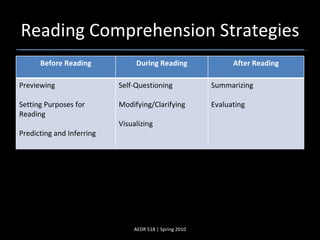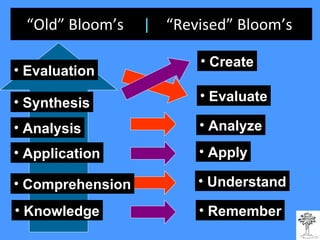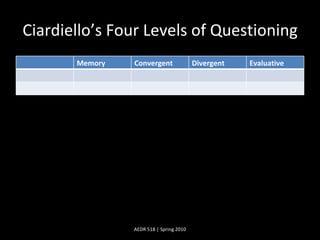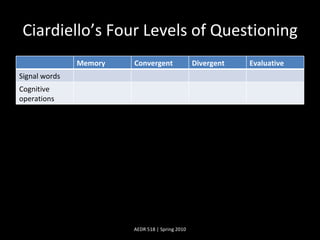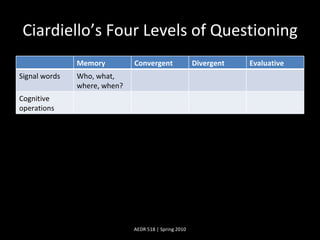Levelsofquestioning
- 1. Reading Comprehension and Levels of Questioning in the Content Area AEDR 518 | Spring 2010
- 2. Chapter 8: “Organizing for Teaching and Learning” What lesson planning format will we use? How can we differentiate instruction to accommodate students’ needs? How can we group students for learning? How can we effectively use textbooks in the content area? How can students read content area text without engaging in round-robin reading? but first….. AEDR 518 | Spring 2010
- 3. Levels of Questioning Context: Bloom’s Taxonomy (revised) Strategy: Ciardiello’s Levels of Questioning AEDR 518 | Spring 2010
- 4. Reading Comprehension Strategies AEDR 518 | Spring 2010 Before Reading During Reading After Reading Previewing Setting Purposes for Reading Predicting and Inferring Self-Questioning Modifying/Clarifying Visualizing Summarizing Evaluating
- 5. Reading Comprehension Strategies Generating Questions AEDR 518 | Spring 2010
- 6. Levels of Questioning Context: Bloom’s Taxonomy (revised) Strategy: Ciardiello’s Levels of Questioning AEDR 518 | Spring 2010
- 7. AEDR 518 | Spring 2010
- 8. “ Old” Bloom’s | “Revised” Bloom’s Remember Apply Understand Analyze Evaluate Create Evaluation Analysis Synthesis Application Comprehension Knowledge
- 10. Bloom | Verb List
- 11. Ciardiello’s Four Levels of Questioning Memory Convergent Divergent Evaluative AEDR 518 | Spring 2010
- 12. Ciardiello’s Four Levels of Questioning AEDR 518 | Spring 2010 Memory Convergent Divergent Evaluative
- 13. Ciardiello’s Four Levels of Questioning AEDR 518 | Spring 2010 Memory Convergent Divergent Evaluative Signal words Cognitive operations
- 14. Ciardiello’s Four Levels of Questioning AEDR 518 | Spring 2010 Memory Convergent Divergent Evaluative Signal words Who, what, where, when? Cognitive operations
- 15. Ciardiello’s Four Levels of Questioning AEDR 518 | Spring 2010 Memory Convergent Divergent Evaluative Signal words Who, what, where, when? Cognitive operations Naming, defining, identifying, designating
- 16. Ciardiello’s Four Levels of Questioning AEDR 518 | Spring 2010 Memory Convergent Divergent Evaluative Signal words Who, what, where, when? Why, how, in what ways? Cognitive operations Naming, defining, identifying, designating
- 17. Ciardiello’s Four Levels of Questioning AEDR 518 | Spring 2010 Memory Convergent Divergent Evaluative Signal words Who, what, where, when? Why, how, in what ways? Cognitive operations Naming, defining, identifying, designating Explaining, stating relationships, comparing and contrasting
- 18. Ciardiello’s Four Levels of Questioning AEDR 518 | Spring 2010 Memory Convergent Divergent Evaluative Signal words Who, what, where, when? Why, how, in what ways? Imagine, suppose, predict, if/then Cognitive operations Naming, defining, identifying, designating Explaining, stating relationships, comparing and contrasting
- 19. Ciardiello’s Four Levels of Questioning AEDR 518 | Spring 2010 Memory Convergent Divergent Evaluative Signal words Who, what, where, when? Why, how, in what ways? Imagine, suppose, predict, if/then Cognitive operations Naming, defining, identifying, designating Explaining, stating relationships, comparing and contrasting Predicting, hypothesizing, inferring, reconstructing
- 20. Ciardiello’s Four Levels of Questioning AEDR 518 | Spring 2010 Memory Convergent Divergent Evaluative Signal words Who, what, where, when? Why, how, in what ways? Imagine, suppose, predict, if/then Defend, judge, justify/what do you think? Cognitive operations Naming, defining, identifying, designating Explaining, stating relationships, comparing and contrasting Predicting, hypothesizing, inferring, reconstructing
- 21. Ciardiello’s Four Levels of Questioning AEDR 518 | Spring 2010 Memory Convergent Divergent Evaluative Signal words Who, what, where, when? Why, how, in what ways? Imagine, suppose, predict, if/then Defend, judge, justify/what do you think? Cognitive operations Naming, defining, identifying, designating Explaining, stating relationships, comparing and contrasting Predicting, hypothesizing, inferring, reconstructing Valuing, judging, defending, justifying
- 22. Don’t forget: You can copy-paste this slide into other presentations, and move or resize the poll.
- 23. Don’t forget: You can copy-paste this slide into other presentations, and move or resize the poll.
- 24. Ciardiello’s Four Levels of Questioning AEDR 518 | Spring 2010 Content area examples
- 25. Ciardiello’s Four Levels of Questioning Think about generating questions. Choose a section from your content textbook. Develop two questions at each Ciardello level . Share your questions with others in the group. Select the “best” question for each level. Report that best question to the class. Explain the level and where it fits on Bloom’s taxonomy as well. AEDR 518 | Spring 2010 Activity
Editor's Notes
- Changes were based on 50+ years of consistent history of using Taxonomy for Learning Teaching and Assessing (Bloom’s Taxonomy) The names of six major categories were changed from noun to verb forms. The word knowledge was inappropriate to describe a category of thinking and was replaced with the word remembering instead. Comprehension and synthesis were retitled to understanding and creating respectively, in order to better reflect the nature of the thinking defined in each category. Create took the place of Synthesis and moved to signify a more cognitively complex position on the matrix
- Press F5 or enter presentation mode to view the poll If you like, you can use this slide as a template for your own voting slides. You might use a slide like this if you feel your audience would benefit from the picture showing a text message on a phone.
- Press F5 or enter presentation mode to view the poll If you like, you can use this slide as a template for your own voting slides. You might use a slide like this if you feel your audience would benefit from the picture showing a text message on a phone.



